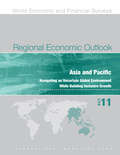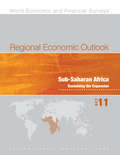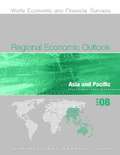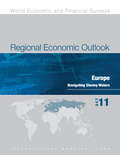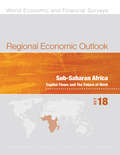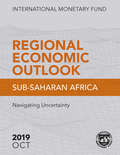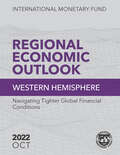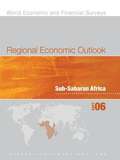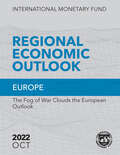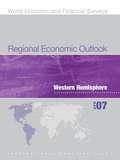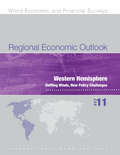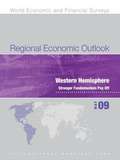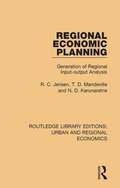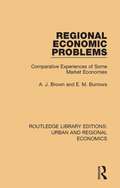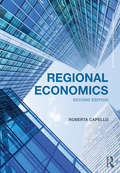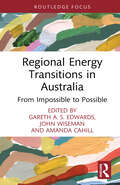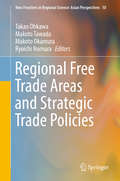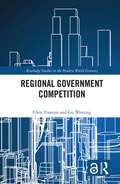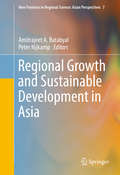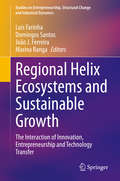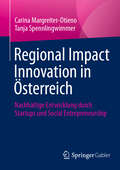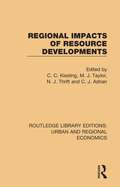- Table View
- List View
Regional Economic Outlook, October 2011
by International Monetary FundThe two sections of this biannual report assess economic conditions in the Middle East, North Africa, Afghanistan, and Pakistan (MENAP), and in the Caucasus and Central Asia (CCA). Amidst the 4% global growth projected for 2012, the IMG staff recommends further monetary tightening in some countries and a comprehensive reform agenda for improving social mobility through more access to economic opportunity. A statistical appendix lists data for 30 countries during 2006 through 2010 with projections for 2011 and 2012. Annotation ©2012 Book News, Inc. , Portland, OR (booknews. com)
Regional Economic Outlook, October 2011: Sub-Saharan Africa - Sustaining the Expansion
by International Monetary FundThe International Monetary Fund publishes this report on the regional economic outlook in Sub-Saharan Africa and the quality of growth twice a year. This edition presents the inclusiveness of the region's recent high-growth episode based on an analysis of the evolution of consumption for the poorest quartiles in case studies of six countries (Cameroon, Ghana, Mozambique, Tanzania, Uganda, and Zambia), including the disconnect between recent growth and poverty outcomes, as well as the extent to which countries have been able to latch on to the new growth market. It also addresses risks and threats to growth and policy challenges. No index is provided. Annotation ©2012 Book News, Inc. , Portland, OR (booknews. com)
Regional Economic Outlook: Asia and Pacific APR, 08
by International Monetary FundConsisting of a mere 41 pages, this financial survey contains highly specialized information on economic activity in Asia and the Pacific in the year 2008, and how slowing growth in Europe and the United States may present severe challenges in the coming year. Prepared by the International Monetary Fund's Asia and Pacific Department, this survey offers plenty of relevant and objective data for global investors and businessmen who need hard facts to form an effective and resilient financial strategy for the coming financial quarters. Annotation ©2008 Book News, Inc. , Portland, OR (booknews. com)
Regional Economic Outlook: Europe Navigating Stormy Waters
by International Monetary FundThe September 2011 survey projects continued growth in Europe during 2012 and a healthy decline in inflation, and demonstrates how sound macroeconomic policies and growth-enhancing structural reforms raise a country's growth potential by fostering balanced growth and raising TFP growth. The biannual report also examines the economic and financial ties between Eastern Europe and Western Europe, and quantifies how shocks originating in Western Europe affect economic developments in Eastern European countries. Color data graphs are provided but no index. Annotation ©2012 Book News, Inc. , Portland, OR (booknews. com)
Regional Economic Outlook: Fostering Durable And Inclusive Growth (Regional Economic Outlook Ser. #Regional Economic Outlook)
by International Monetary FundA report from the International Monetary Fund.
Regional Economic Outlook: Fostering Durable And Inclusive Growth (Regional Economic Outlook Ser. #Regional Economic Outlook)
by International Monetary FundA report from the International Monetary Fund.
Regional Economic Outlook: Pandemic Persistence Clouds The Recovery (Regional Economic Outlook Ser.)
by International Monetary Fund. Western Hemisphere Dept.A report from the International Monetary Fund.
Regional Economic Outlook: Sub-Saharan Africa, Sept 2006
by International Monetary FundProvides a broad synopsis of recent economic developments in the Middle East and Central Asia region, highlighting common trends and policies among countries in the region, and reviewing prospects and policies for the coming year. Includes a statistical appendix.
Regional Economic Outlook: The Fog Of War Clouds The European Outlook (Regional Economic Outlook Ser.)
by ImfA report from the International Monetary Fund.
Regional Economic Outlook: Western Hemisphere
by International Monetary FundA report from the International Monetary Fund.
Regional Economic Outlook: Western Hemisphere Shifting Winds, New Policy Challenges, October 2011
by International Monetary FundPart one of the October 2011 report explores U. S. and Canadian policy options for supporting continued growth while part two evaluates the economic outlook for South America, Mexico, Central America, and the Caribbean. The last section puts the recent commodity boom in historical perspective and examines the role of specific policies and fundamentals in determining the impact of trade shocks on domestic output. Color maps and graphs are provided but no index. Annotation ©2012 Book News, Inc. , Portland, OR (booknews. com)
Regional Economic Outlook: Western Hemisphere Stronger Fundamentals Pay Off, May 2009
by International Monetary FundThe global crisis that began in advanced economies has sent severe shocks around the world, posing a test to the economies of Latin America and the Caribbean. the good news is that during this decade the region has made itself more resilient to external shocks, by strengthening policy frameworks and reducing vulnerabilities in its public finances and financial systems. These preparations, the report shows, mean that countries are now more able to respond to the external crisis, many for the first time, with active policies to boost output and employment and protect the most vulnerable groups. This will help contain the damage from the global crisis and speed up the region's recovery.
Regional Economic Planning: Generation of Regional Input-output Analysis (Routledge Library Editions: Urban and Regional Economics)
by R. C. Jensen T. D. Mandeville N. D. KarunaratneOriginally published in 1979. Decision makers at all levels need sufficiently detailed information on regional economic structure in order to undertake consistent and comprehensive regional planning. A means is put forward here, elevating the impracticable regional input-output method, to that of an operational planning technique. This development represents a system which facilitates the examination both of the economic structure of individual regions in reasonable detail, and of the regional structure of the state economy. The technique, termed the Generation of Regional Input-Output Tables (GRIT), is designed for general use in the production of regional input-output tables, and other data sources contributing towards the holistic accuracy of the table, thereby providing accurate maximisation of input-output tables within a given budget constraint.
Regional Economic Problems: Comparative Experiences of Some Market Economies (Routledge Library Editions: Urban and Regional Economics)
by A. J. Brown E. M. BurrowsOriginally published in 1977. This book provides the first concise non-technical account of what the main kinds of regional problems are, how they arise, and the kinds of policy which have been used to tackle them in the UK, USA and Western Europe. The book starts with a discussion of why "regional problems" really are situations which call for special action, followed by a short preliminary classification of problem regions (including those in the less developed countries), then on to a more detailed survey of the origins and experience of selected problem regions in the more developed market economies. The authors focus on four broad kinds of problem region; agricultural regions, coal mining regions, old textile regions, and so-called "congested" regions. They conclude with a selective survey of regional policies in these more advanced economies, distinguishing and comparing the main trends and the different national styles.
Regional Economics
by Roberta CapelloThe second edition of Regional Economics provides a comprehensive and up-to-date treatment of regional economics. This fully revised edition includes key theoretical developments of the last ten years. Topics included span from the earliest location theories to the most recent regional growth theories. It is also is also enriched by the recent debate on smart specialization strategies recently developed by the EU for the design of new cohesion policies. Key elements covered in the new edition include: proximity and innovation theories the concept of territorial capital the debate on the role of agglomeration economies in urban growth This textbook is for undergraduate students in regional and urban economics as well as spatial planning courses.
Regional Energy Transitions in Australia: From Impossible to Possible (Routledge Studies in Energy Transitions)
by John Wiseman Edwards, Gareth A. S. Amanda CahillThis book provides an accessible and critical appraisal of Australia’s regional energy transition initiatives.The book begins by situating Australian energy transition in the context of Australian and international debates about climate change and energy transition. It then explores how energy transition planning was made possible in Australia’s regional energy heartlands even while public transition planning was impossible. The authors consider five case studies of key early transition initiatives in the Latrobe Valley (Victoria), Hunter Valley (NSW), Central Queensland (Queensland), Port Augusta (South Australia) and Collie (Western Australia). They explore how transition came onto the agenda and outline the key actors, decision points and actions. The authors critically assess the successes and failures of each initiative, drawing out key learnings for other regions. The book concludes by evaluating the key cross-cutting themes emerging from the five case studies and draws out the lessons they teach about how to achieve a just transition.This concise book will be of great interest to students and scholars of energy transitions, climate action, social justice, economic renewal and regional transition challenges and strategies, both in Australia and overseas.
Regional Financial Integration in the Caribbean: Evidence from Financial and Macroeconomic Data
by Goohoon Kwon Raphael EspinozaA report from the International Monetary Fund.
Regional Financial Integration in the GCC
by Oral Williams Raphael Espinoza Ananthakrishnan PrasadA report from the International Monetary Fund.
Regional Financial Interlinkages and Financial Contagion Within Europe
by Zsófia Árvai Inci Ötker-Robe Karl DriessenA report from the International Monetary Fund.
Regional Free Trade Areas and Strategic Trade Policies
by Takao Ohkawa Makoto Tawada Makoto Okamura Ryoichi NomuraThis book presents a theoretical investigation of the formation of regional free trade agreements (FTAs), the behavior of global enterprises, and government trade policies in various game forms including multi-stage games, repeated games, and timing games. In the last few decades, the number of FTAs has been rapidly increasing in the world, especially in Asia. In particular, East Asian countries are expected to be main engines for sustaining the world economy. Focusing on East Asian economies, strategic behaviors of governments and firms in order to attain their own aims are examined. The analytical methods employed in this book are those currently being developed or that recently have been created. The topics are important contemporary issues in regional areas facing the rapid economic changes brought about by globalization. Most chapters of this book are based on original work that was published in international journals but now has been completely rewritten, with restructuring and extension of the original work. This book, with its up-to-date information, will be of interest to academic researchers in universities and economic research institutions and to students working on advanced degrees in economics.
Regional Government Competition (Routledge Studies in the Modern World Economy)
by Chen Yunxian Gu WenjingThis monograph provides a coherent and systematic explanation of China’s regional economic development from the perspective of regional government competition. It gives an almost unknown exposition of the mechanisms of China's regional economic development, with numerous supporting cases drawn from both China and elsewhere. This book is an invaluable resource for anyone interested to learn more particularly the development and transformation of China’s regional economy from both the Chinese and global perspectives.
Regional Growth and Sustainable Development in Asia
by Peter Nijkamp Amitrajeet A. BatabyalThis book addresses two general questions that have arisen as a result of the uneven rise of the various Asian economies in contemporary times. First, to lift people out of poverty and to improve the quality of their lives, how do we institute policies that will ensure economic growth in the different regions of Asia? Second, what can we do to ensure that the economic growth we seek is sustainable so that the regional economic development that emerges is broad-based, inclusive, and environmentally conscious? Specifically, this edited book will provide a unified perspective on regional growth and sustainable development in Asia by focusing on the above two broad questions. The book will emphasize dynamic modeling and it will illustrate the role that sound theoretical and empirical modeling of an intertemporal nature can play in shedding light on salient public policy questions concerning regional growth and sustainable development. The specific topics to be addressed in this book include growth accounting, natural resource use and management, the regulation of environmental externalities, geographic information systems, and regional climate change. The individual chapters in this book will be written by international experts who are also active researchers in their respective fields. Therefore, this book is highly recommended to all readers who seek an in-depth and up-to-date perspective on some of the most salient issues at the interface of regional growth and sustainable development in Asia.
Regional Helix Ecosystems and Sustainable Growth: The Interaction of Innovation, Entrepreneurship and Technology Transfer (Studies on Entrepreneurship, Structural Change and Industrial Dynamics)
by João J. Ferreira Luís Farinha Marina Ranga Domingos SantosThis book discusses the importance of innovation and entrepreneurial ecosystems in supporting regional competitiveness. It also encourages academics, business professionals and policy-makers to rethink innovation ecosystems as drivers of regional competitiveness, demonstrating the complex interactions between regional economic and social actors, and their impact on regional competitiveness. Further, the book examines the role of entrepreneurship and innovation policies in different regions (e.g. lagging regions, rural regions, etc.), and describes critical success factors in multi-level technologies and innovation policies and strategies.
Regional Impact Innovation in Österreich: Nachhaltige Entwicklung durch Startups und Social Entrepreneurship
by Tanja Spennlingwimmer Carina Margreiter-OtienoDieses Buch analysiert die österreichische Innovationslandschaft und zeigt auf, welche Bedeutung Startups und Social Entrepreneurship für nachhaltige Entwicklung und das Erreichen der Sustainable Development Goals (SDGs) haben. Die Autorinnen präsentieren verschiedene Methoden, wie der Impact von Innovationen gemessen werden kann, sowie Förderprogramme und Finanzierungsmechanismen für Startups, ergänzt von Best Practices und Erfolgsgeschichten. Das Buch bietet wertvolle Einblicke für alle, die sich mit der Startup-Politik und der Innovationslandschaft speziell in Österreich, aber auch im DACH-Raum beschäftigen. Es richtet sich an Unternehmer*innen, Investor*innen und politische Entscheidungsträger*innen, die an der Förderung und Messung von sozial und ökologisch orientierten Innovationen interessiert sind.
Regional Impacts of Resource Developments (Routledge Library Editions: Urban and Regional Economics)
by Michael Taylor Nigel Thrift Christopher C. Kissling Colin AdrianOriginally published in 1984. Australia is a resource-rich country deriving a significant proportion of its export earnings from trade in these resources. At the same time, the country is young, sparsely populated beyond the coastal fringe, particularly in the resource-rich areas, and environmentally fragile. The consequences of resource exploitation in these areas have far-reaching policy implications. A range of these concerns is canvassed in this volume, encompassing the views of policy-makers, planners and academics. Five chapters address social and economic impacts ranging over manufacturing and tertiary industry, immigration and labour markets, employment and population and the provision of educational facilities. Many of these are seen in microcosm in the Hunter Valley, New South Wales. Two contributions offer an international perspective, one in another federal system – Canada – and one where Australian interests are participating in resource extraction – Papua New Guinea. The issues raised are fundamental to Australia's development in the 1980's and of importance to everyone connected with the development and planning of Australia's future.
